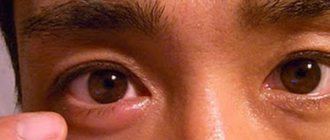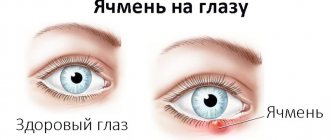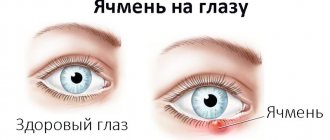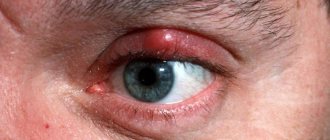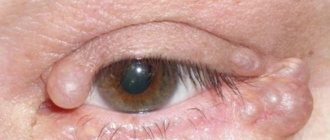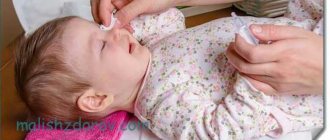Eye diseases require serious attention and immediate treatment. Many parents of young children know firsthand what barley is. To prevent the disease, it is important to know the mechanism of its occurrence. From the article you will learn what symptoms are characteristic of each stage of the lesion, and also become familiar with the main drugs, the use of which is advisable at the first signs and complications.
Causes
Styes on the eyelid occur as a result of pathogenic bacteria entering one or more eyelash follicles, which are located near the skin of the eyelid.
The most common causative agent of this disease is staphylococcus. The staphylococcus bacillus lives on the surface of the face, but if your body is too weak to repel the attack, it can cause infection.
Barley occurs quite often and accompanies colds, flu, and significantly reduced immunity.
Also, if the patient has blepharitis - various types of inflammation of the edges of the eyelids that are difficult to treat, then this also increases the chances of contracting stye.
Causes of stye and risk groups
There are two main causes of this disease: weak immunity and poor hygiene. The second does not mean that you need to spend time in unsanitary conditions; it will be enough if you scratch your eye with unwashed hands. Representatives of the fair sex can easily acquire this disease thanks to low-quality cosmetics. The majority of people more susceptible to developing this disease are children who involuntarily rub their eyes and women, since they often have to put on makeup. There are cases of a hereditary form, but this is already at the genetic level, and here you should be under the constant supervision of a doctor.
Stye on the eye most often occurs during the cold season, when the immune system is weakened. Main reasons:
- Hypothermia. Against the background of a slowdown in metabolic processes and deterioration of thermoregulation, staphylococci and streptococci develop.
- Violation of personal hygiene rules. This could be using someone else's towel.
- Avitaminosis. This state is typical for spring, when the body is in an exhausted state.
- Diseases of the endocrine system. Hormonal imbalance can lead to the invasion of pathogenic microflora and the appearance of barley.
Sometimes the cause of the inflammatory process can be disturbances in the functioning of the gastrointestinal tract. As a result, beneficial substances from foods are not completely absorbed, the body does not receive enough vitamins, and this reduces immunity.
At-risk groups:
- children;
- owners of oily skin type;
- patients with diabetes mellitus or gastrointestinal diseases;
- contact lens users.
Children most often neglect hygiene rules and can easily get an infection in their eyes. People with oily skin types have wide sebaceous glands through which pathogens can penetrate.
Patients with diabetes and other diseases have weak immune systems. Sometimes contact lens users neglect proper and regular care of their optical products.
What does barley look like?
The process begins with local redness, inflammation of the eyelid area, painful when touched or blinked. A mature boil is characterized by a white purulent cap, which over time can burst, which immediately brings significant relief to the patient. If the process is deep, then the opening of the abscess is performed surgically.
Classification
Barley that has “jumped up” on the outer part of the patient’s eyelid is classified as external hordeolum, and on the inside - accordingly, internal barley.
External barley is clearly visible upon examination, even when it is not yet ripe.
Expert opinion
Danilova Elena Fedorovna
Ophthalmologist of the highest qualification category, Doctor of Medical Sciences. Has extensive experience in diagnosing and treating eye diseases in adults and children.
The inner stye can only be seen if you pull the eyelid outward. Typically, the skin around a yellowish stye appears redder and inflamed than the skin of a healthy eyelid. The disease of the inner eyelid can last longer than the outer eyelid and it is better to pay attention to such styes so that the infection does not spread further.
Internal stye occurs in medical practice much less frequently than external stye, and leads to complications, so when it appears, it is better to immediately seek help.
Typically it develops in only one eye, but there are cases where the infection can affect both eyes.
Possible complications
Untreated stye on the eye often leads to relapses, that is, to the return of the disease after a seemingly complete recovery. In addition, self-squeezing out pus contributes to the spread of infection in the body. This can cause inflammation of the orbital (orbital) tissue - orbital phlegmon. As the inflammatory process develops, the patient's vision sharply decreases, and the eyeball becomes inactive.
In turn, a critical complication of orbital phlegmon is a brain abscess - the appearance of pus in the cranial cavity. Fortunately, brain abscess is extremely rare in developed countries. But there are much more cases associated with blood poisoning or the appearance of cystic formations (all of this can also be caused by inattention to the “sore” or unsuccessful self-medication).
But perhaps the most common complication is the development of chalazion (popularly known as “hailstone”) after internal stye. This is a chronic but harmless inflammation around the meibomian gland (located on the eyelids), in which a small, round-shaped lump forms. Such “swelling” causes aesthetic discomfort and is most often removed with a laser.
Drops
Modern eye drops contain antibiotics, antihistamines, decongestants and analgesics. When choosing a medicine, pay attention to the fact that the active substance must act on staphylococcal infections.
When choosing a medicine, it is better to consult a doctor, he will help you choose a drug that will quickly cope with the infection, since staphylococcus can mutate and develop resistance to some drugs.
How to apply eye drops correctly?
The medicine, released in the form of drops, is more convenient than ointment; it can be used anywhere. The drops are absorbed faster; there is no need to rub them into the eye.
The correct sequence of actions when instilling medicine:
- Make sure your hands are clean.
- Shake the bottle with drops and open the cap.
- Tilt your head back or lie on your back.
- Pull the lower eyelid down with one or two strokes.
- Press the bottle so that the drop gets between the eyeball and the eyelid.
- Close your eye and gently massage the inner corner of your eye for a couple of minutes or just lie quietly.
- Close the bottle and store it in a cool, dark place.
Removing styes
There are three methods for treating stye on the eye. They prescribe medications, allow the use of traditional methods, or set a day for the operation.
To get rid of hordeolum without complications, you need to consult an ophthalmologist before using medications.
Medicines
Drug treatment is effective at any stage of development. Patients are prescribed antibacterial, antiseptic and anti-inflammatory drugs in the form of drops and ointments.
Eye drops
It is better to carry out instillation in front of a mirror, this will help to correctly coordinate movements and not get missed, damaging the mucous membrane. Before using the drops, wash your hands thoroughly with soap and warm the solution with the drops in your hands to body temperature, rolling it in your palms.
For barley, the following drugs are prescribed:
- Phloxal;
- Levomycetin;
- Tobrex;
- Albucid;
- Vitabact;
- Garazon;
- Azidrop;
- Tsipromed;
- Tsiprolet and others.
They cannot be used in case of individual intolerance to the components; many are contraindicated during pregnancy and lactation. When buying medicine, children should check at what age they are allowed to use it.
For the treatment of hordeolum in children, Albucid, Tobradex, Sulfacyl sodium, Oftalmoferon are used. Other products are permitted for adults.
Ointments
In the first days of development of hordeolum, they are not prescribed, since there is still a chance that it will go away on its own. If this does not happen, you should consult a doctor who will prescribe a specific remedy.
You can remove hordeolum with the following ointments:
- Hydrocortisone;
- Tetracycline;
- Erythromycin.
Treatment with ointments is carried out until the barley ripens. When the contents of the capsule are released, it is necessary to use antiseptic drops to rinse the eye. After which they switch back to using ointments.
They relieve inflammation, relieve pain and speed up healing. The ointment creates an invisible film on the surface of the mucous membrane and the resulting wound, protecting the eyes from dust and debris.
Use ointments according to instructions. For example, Hydrocortisone is administered up to 5 times a day, and Erythromycin - no more than 3 times. Last use is before bedtime. After which the eye needs to rest, do not read or watch TV.
Each ointment has its own contraindications, which are important to consider before purchasing. Do not use for more than 2 weeks; further use must be agreed with an ophthalmologist.
Alcohol solutions
It is allowed to use brilliant green and iodine to treat barley. Use alcohol solutions carefully; if a drop of the substance gets on the mucous membrane, a strong burning sensation will occur, and you can get a burn to the mucous membrane.
Apply with a cotton swab. At the same time, use ointments, drops and tablets that have antibacterial and anti-inflammatory effects. Treatment is carried out until complete recovery.
Alcohol solutions cauterize and kill bacteria. They allow you to get rid of the disease in a couple of days if the barley was at the initial stage of development. Use frequently, taking a break of 1-2 hours between procedures. If there is active inflammation and an abscess has broken through, they cannot be used.
Surgical intervention
If the hordeolum is large or drug therapy does not bring the desired result, surgery is prescribed. Surgical intervention consists of puncturing the capsule containing purulent contents and draining the fluid through a small incision.
The doctor uses antiseptic drugs and cleanses the capsule with their help to prevent relapse of the disease. Then antibiotics, rinses and the use of immunostimulating medications are prescribed.
Surgical removal of stye from the eye
Removing a hordeolum from an eyelid will not be difficult; the main thing is to follow the doctor’s instructions correctly after surgery so as not to re-infect.
It is not recommended to open an abscess on your own; this is fraught with serious consequences. As a result of such actions, the development of phlegmon, sepsis, the spread of infection into the cranial cavity and the formation of purulent conjunctivitis are possible.
ethnoscience
The appearance of stye on the eye is not only an aesthetic problem. The disease causes a lot of unpleasant symptoms. Traditional healers suggest using proven remedies in addition to medications.
Recipes against stye on the eye:
- Garlic in any form is applied to the swollen eyelid up to 4 times a day. Keep the compress for 25 minutes. Do not soak the gauze in garlic juice, as it will get into your eyes and cause burning and irritation.
- Coriander seed relieves pain and swelling. Soak in water for several hours, squeeze out the water, and use for rinsing. Carry out the procedure up to 6 times a day for 1 week.
- At the initial stage of the disease, plantain is used. The leaves of the medicinal herb are applied to the eyelids, first washed and dried. Secure with a gauze bandage and leave overnight.
- Calendula and chamomile flowers are effective for barley. Herbs relieve inflammation, reduce swelling and pain. 0.5 tbsp. l. Pour hot water over medicinal herbs and leave in a thermos. Do not use steep boiling water; it deprives the herbs of their healing powers. Strain the medicine. Use for compresses and lotions. Use 4-8 times a day.
- Onion compress helps to quickly eliminate the problem. Place a slice of onion in a frying pan with oil and fry until it starts to smoke. Then put it in a bandage and apply it to the sore eyelid. Wait for it to cool, remove the compress and do it all over again next time. Do the procedure 4 times a day.
Traditional treatment is not a panacea for all diseases. Only folk remedies will not help get rid of gordeolum. Therapy is carried out in combination with medications.
By following the doctor's recommendations on hygiene and following the prescribed treatment tactics, barley can be quickly eliminated. With the right approach to therapy, the disease proceeds without complications, the hordeolum resolves on its own or breaks through.
Ointments for pathology - which one to use?
There are inconveniences in treating with eye ointment due to the fact that after using them, vision becomes blurry for a while and you need to wait longer than when using drops for the medicine to wear off.
The ointment is relatively convenient to use at night. With clean hands, place about 3-4 mm of ointment evenly behind the eyelid, then blink intensely and allow the ointment to be absorbed.
Tetracycline
One of the most common eye ointments suitable for treating stye is 1% tetracycline ointment. An inexpensive and proven remedy for eye diseases with a wide spectrum of action.
Among the disadvantages of use is that it has a sharp, unpleasant odor, although it dissipates quite quickly.
Medicines for children
Barley in children is a very common occurrence. Today there are a large number of effective antibacterial drugs that can be used from an early age. Among them are the following medications:
- Albucid;
- Tobrex;
- Levomycetin;
- Dexamethasone;
- Phloxal;
- Sulfacyl sodium.
Such medications against barley on the eye have almost no contraindications and do not cause side effects. But you should not use them without the knowledge of your doctor.
What to do to prevent a relapse?
Rinse your eyes regularly with clean, preferably boiled water and wipe your face only with a clean towel. During the course of the disease, it is better to use a separate towel so as not to infect family members.
For rinsing, you can use a cotton swab soaked in a solution of furatsilin or chamomile decoction.
Before washing and instilling medications, be sure to wash your hands with soap. This is especially true for young children, who often suffer from “dirty hands” diseases.
Important! During treatment, it is not recommended to use eye cosmetics and contact lenses to avoid re-infection. Never use decorative and skin care cosmetics whose expiration date has already passed.
You may need to change your mascara or eyeliner to prevent further spread of infection through cosmetics.
Some people have stye infrequently, while others have it every autumn-winter period during a cold. If it occurs more than 2-3 times a year, it is better to get tested to identify chronic diseases that can undermine the immune system and consult with an immunologist.
Watch your diet so that it is balanced. If necessary, take a course of vitamins to generally strengthen the body.
Useful video
How to cure stye on the eye in a day at home:
Stye on the lower eyelid
The incubation process lasts on average 7–10 days. The disease is more complicated. Can be internal and external.
initial stage
Localized closer to the surface of the epidermis. It is difficult to determine it at the initial stage. A person can only feel how the pathology develops.
Hordeolum on the lower eyelid manifests itself as redness, swelling and itching. The swollen area turns pink and swells. There is no abscess. These symptoms are enough to make a diagnosis.
Active inflammation
Without treatment, the painful area turns red and swells. The swelling may interfere with normal vision of surrounding objects.
A light touch causes sharp pain. There is severe swelling around the inflammation. Watery eyes appear and the mucous membrane of the eye turns red. Sometimes patients experience mild intoxication.
In the phase of active inflammation, regional lymph nodes enlarge. Body temperature rises. This occurs more often if the lesion consists of several infiltrates merging together.
With several styes, severe headaches appear.
By the end of 1 week, a vial with transparent contents appears. Then an abscess forms at this place.
The process does not always reach the formation of an abscess. A slight swelling may disappear as suddenly as it appeared.
The last stage is the opening of the purulent head
It opens on its own after 7–10 days. Do not squeeze or pierce.
Upon opening, pus appears with particles of dead tissue. After the contents come out, the pain subsides. The pus does not come out all at once. Cleansing occurs over several days.
After the contents are released, swelling and puffiness persist for 2-3 days until the infection goes away. The redness remains and gradually subsides.
If hordeolum appears, you cannot treat it yourself. Any eye disease must be diagnosed by a doctor. The ophthalmologist will prescribe the correct treatment to help quickly get rid of inflammation and the spread of infection.
Author's rating
Author of the article
Alexandrova O.M.
Articles written
2029
about the author
Was the article helpful?
Rate the material on a five-point scale!
( 5 ratings, average: 4.80 out of 5)
If you have any questions or want to share your opinion or experience, write a comment below.
Prevention
The following preventive measures will help prevent the development of eye stye:
- adhere to the rules of personal hygiene;
- Healthy food;
- strengthen immunity;
- avoid hypothermia;
- exclude communication with sick people;
- use contact lenses correctly;
- Do not paint your eyes with someone else's cosmetics.
It is necessary to promptly treat any diseases, preventing them from becoming chronic.
Author of the article: Kvasha Anastasia Pavlovna, specialist for the website glazalik.ru Share your experience and opinion in the comments.
